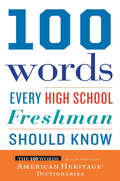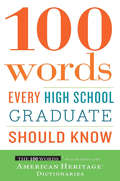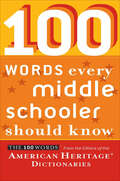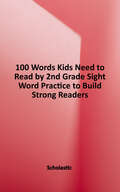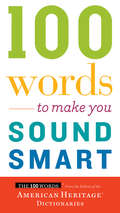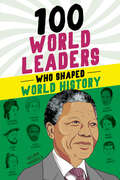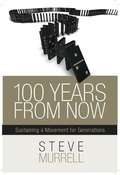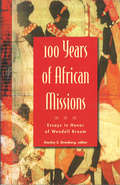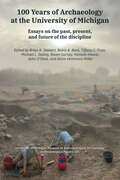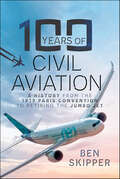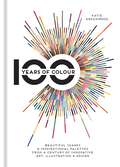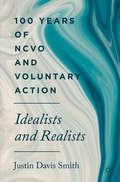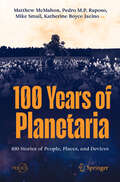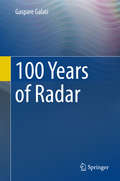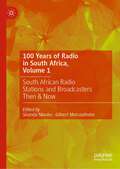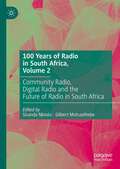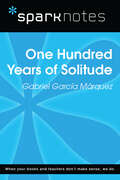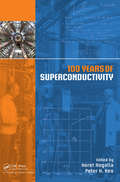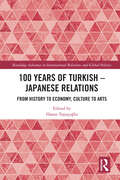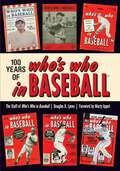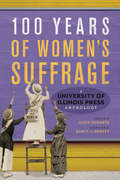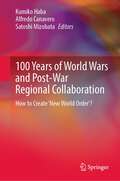- Table View
- List View
100 Words Every High School Freshman Should Know
by Editors of American Heritage DictionariesFollowing the success of 100 Words Every High School Graduate Should Know, the editors of the American Heritage® Dictionaries have developed this new book of 100 words tailored especially to high school freshmen. This second book in the 100 Words series focuses on the kinds of words that a successful middle school graduate can learn from rigorous coursework in a variety of subjects and that nearly every freshman will encounter over the course of the school year.The words have been chosen with various criteria in mind. Some represent key concepts in important areas of the curriculum, while others are more familiar in meaning but present challenges of spelling or usage. All are words that students can expect to see regularly in their high school reading and beyond. And each word is fully defined as well as shown in typical contexts with example sentences and quotations, many of which are taken from award-winning authors such as Harper Lee, George Orwell, Katherine Paterson, and John Knowles. Together, these 100 words represent the increasingly sophisticated and complex vocabulary that freshmen must master as they continue their education at the next level. To learn them is not only to gain useful knowledge -- it is to step into a broader world.
100 Words Every High School Graduate Should Know
by Editors of American Heritage DictionariesWhat should the vocabulary of a well-rounded high school graduate be like? These 100 words provide the starting point in answering that question. The list is representative of the words that serious students will encounter in their coursework and will come to use as adults, whether in conversation or while reading the daily newspaper. Each word is fully defined and shown in context with example sentences from well-known authors. 100 Words Every High School Graduate Should Know is a must-have for every grad, perfect for building vocabulary, quizzing friends and family -- and just having fun.
100 Words Every High School Graduate Should Know
by The Editors of the American Heritage DictionariesIn addition to carefully choosing a well-balanced mix of terms from A to Z, the book balances straightforward vocabulary entries, such as bellicose, loquacious, and vehement, with words chosen directly from the disciplines of learning, such as parabola and hypotenuse from mathematics, gerrymander and enfranchise from civics, and photosynthesis and hemoglobin from biology. As a result, students often have an easier time with the list than adults, especially if they've been paying attention in their classes! The book also offers exercises at the end of the text to assist in the incorporation of the words into one's active vocabulary.
100 Words Every Middle Schooler Should Know (100 Words Ser.)
by Editors of American Heritage DictionariesMore is expected of middle schoolers--more reading, more writing, more independent learning. Achieving success in this more challenging world requires knowing many more words. 100 Words Every Middle Schooler Should Know helps students in grades 6 to 8 (ages 11-14) to express themselves with distinction and get the most out of school.The 100 words are varied and interesting, ranging from verbs like muster and replenish to nouns like havoc and restitution to adjectives like apprehensive and imperious. Knowing these words enables students to express themselves with greater clarity and subtlety. Each word has a definition and a pronunciation and appears with at least one quotation--a moving or dramatic passage--taken from a book that middle schoolers are assigned in the classroom or enjoy reading on their own.Both classic and contemporary works of fiction and nonfiction are represented. Among the authors are young adult favorites and award-winners such as Kate Di Camillo, Russell Freedman, Neil Gaiman, E.L. Konigsberg, Lois Lowry, Walter Dean Myers, Katherine Paterson, J. K. Rowling, and Gary Soto. Readers can see for themselves that the words are used by the very best writers in the very best books. It stands to reason that they will see them again and again in higher grades and throughout their lives.100 Words Every Middle Schooler Should Know helps students to gain useful knowledge and prepares them to step into a broader world.
100 Words Kids Need to Read By 2nd Grade: Sight Word Practice to Build Strong Readers
by ScholasticEach workbook reinforces the 100 words that children need to know and it helps them master comprehension, spelling, writing, and usage of each word. Each workbook reinforces the 100 words that children need to know - and it helps them master comprehension, spelling, writing, and usage of each word. Includes: - Fill-in-the-blank stories and sentences - Word riddles, games, and puzzles - Stories that present the words in context - "Guess the Word" activities - Word classifying and sorting activities - Practice using irregular verb forms - Proofreading Practice for use with Grade 2. Each workbook reinforces the 100 words that children need to know and it helps them master comprehension, spelling, writing, and usage of each word.
100 Words To Make You Sound Smart (100 Words Ser.)
by Editors of American Heritage DictionariesBrilliant communication is just a book away.100 Words to Make You Sound Smart is an informative and entertaining resource that can help anyone be right on the money when looking for words that will make a point, seal the deal, or just keep folks listening. Chosen by the editors of the American Heritage Dictionaries, these words will appeal to anyone who wants to be a more compelling communicator—as a worker, consumer, advocate, friend, dinner companion, or even as a romantic prospect. The book includes a colorful variety of words, including handy words of just one syllable (such as glib) and words derived from the names of famous people (such as Freudian slip and Machiavellian).There are expressions from popular culture (catch-22) and words that date back to classical civilization (spartan and stoic). Each word is clearly defined and shown in context with quotations from contemporary sources: magazines, newspapers, broadcast media, movies, and television. For many words, quotations from distinguished authors and speakers are also given and word histories are explained.100 Words to Make You Sound Smart, the best-selling title in the 100 Words series,provides an affordable and enjoyable way to communicate more effectively. It offers the coveted gift of gab to anyone who needs to “say it right”—and to anyone who wants to sound more articulate.
100 World Leaders Who Shaped World History (100 Series)
by Kathy PaparchontisLearn all about the fascinating lives and tremendous impact of 100 influential leaders around the world and throughout history with this fact-filled biography collection for kids 8 and upThis easy-to-read biography collection includes:100 one-page biographies: Find out how these individuals from around the world changed the course of history!Illustrated portraits: Each biography includes an illustration to help bring history to life!A timeline, trivia questions, project ideas, and more: Boost your learning and test your knowledge with fun activities and resources!From Hammurabi to Catherine the Great, Winston Churchill to Nelson Mandela and many more, readers will dive into the lives of 100 kings, dictators, popes, prime ministers, and presidents from all over the world. Organized chronologically, this thoroughly researched biography collection offers a look at how the actions of each leader have affected the course of human history, even hundreds and thousands of years after their reign.
100 Years From Now
by Steve MurrellOver the next century, the world will see changes we can't even imagine. Advances in technology, shifts in demographics, and developments in global politics will all play a part in dramatically transforming our future. But this book is not about predicting the future-it's about understanding the principles that will shape it. Scores of youth-oriented church-planting movements have come and gone quickly over the last century, many of them with the potential to literally change the world for Christ. Unfortunately, most didn't survive because they were unable to maintain what made them so effective in their first twenty years. The same mission, values, and culture that inspire movements must also sustain them. Simple to say. Not so easy to do. 100 Years From Now explores the importance of understanding mission, values, and culture in order to grow and sustain a movement for generations. "100 Years from Now invites a truly global conversation on what the Spirit is saying to the churches about God's mission for every nation. " -Dr. Timoteo Gener, President and Professor of Theology, Asian Theological Seminary
100 Years of African Missions: Essays in Honor of Wendell Broom
by Stanley E. GranbergThe book is organized into four major sections. Section I introduces Wendell Broom. Section II is "God's Call to a Continent: People and Places." Section III "Mission Strategies and Issues". The final section, Section IV, is entitled "Concluding Thoughts" and shares some concluding thoughts on the future of African missions and the African church. The final content chapter is a speech given by Wendell Broom in 1997 to 178 Nigerian evangelists and church leaders which challenged them (and us) to fill in the unevangelized gaps of Africa with a deliberate church-planting strategy to join the churches of West and East Africa by "meeting in the middle." The book concludes with an extensive bibliography of books, research, and articles on African missions by missionaries and authors associated with the Churches of Christ.
100 Years of Archaeology at the University of Michigan: Essays on the Past, Present, and Future of the Discipline (Anthropological Papers Series #101)
by Raven Garvey Brian A. Stewart Michael L. Galaty Tiffany C. Fryer Robin A. Beck Hannah Hoover John O’Shea Alicia Ventresca-MillerThe University of Michigan has been at the forefront of archaeological research for more than 100 years, since 1922, when the Museum of Anthropology (now the Museum of Anthropological Archaeology) was established on the Ann Arbor campus. The goal of its curators for many decades was to create a research and teaching program that emphasized methodological rigor in the analysis of archaeological materials, attempting to solve grand questions about human behavior through fieldwork, collections, and laboratory work. About fifty years ago, the Museum's emphasis shifted to developing archaeological theory when a new generation of curators with processualist leanings made Ann Arbor a testing ground for the so-called New Archaeology. Now, archaeology stands at a crossroads. Some archaeologists refer to the death of archaeological theory. Others stake out opposed camps of generalists and particularists. At U-M, as at many other universities, the past decade has seen a new commitment to collaborative archaeology, working with descendant communities and acknowledging the discipline's roots in colonialism and extraction. In 2022, to celebrate a century of existence, the University of Michigan Museum of Anthropological Archaeology (UMMAA) hosted an international conference to explore possibilities for a middle way: an archaeology for the next 100 years, combining humanistic and scientific approaches, which allows for both agents and systems, description and explanation, science and heritage. This volume is meant to be a snapshot of that conference and this moment in the development of the discipline. Included are most of the papers and posters presented, as well as photographs of the panels and the proceedings.
100 Years of Baseball on St. Petersburg's Waterfront: How the Game Helped Shape a City (Sports)
by Rick VaughnStep onto the field and bear witness to baseball's outsized impact on Florida's Sunshine City.
100 Years of Civil Aviation: A History from the 1919 Paris Convention to Retiring the Jumbo Jet
by Ben SkipperAn examination of civil aviation history from the end of World War I to the retiring of the Jumbo Jet. The book examines a century of civil aviation; in 1919 a fledgling industry was born out of civilianizing First World War bombers. The book covers the design and development of civil aircraft and all the personalities that shaped the industry; it features the hay-day of air travel before the advent of mass passenger transit, and the rise of smaller, austerity airlines. It covers the influence of military aircraft on civil planes, unpacks the laws that govern civil aviation and how they have changed over the past century. It chronicles air disasters, both mechanical and tyrannical, and for the first time, looks at the role of women in civil aviation. Playing its part in times of crisis, civil aviation has led rescue missions and covert operations; civilian pilots were often used to test and transport new aircraft from their manufacturers to the frontline, often unarmed and unescorted. The book ends with the quiet retirement of an icon, amid a global pandemic and what lies in store for a greener flying future.
100 Years of Colour: Beautiful images & inspirational palettes from a century of innovative art, illustration & design
by Katie GreenwoodThis beautiful book features 100 carefully chosen images from the graphic arts, each representing a colour palette for every year of the 20th century. The images are taken from a variety of sources including magazines, book covers, adverts, posters, illustrations and postcards.A perfect source of inspiration for any professionals in the creative arts, the palettes taken from the images are displayed in a number of ratios, demonstrating the different effects achieved when altering the dominant colour. Ten palettes per decade gives an authentic overview of the colours and trends of an era, making this an ideal historical reference for anyone working in set or interior design, graphic design, illustrations or fashion. Not just a collection of pretty palettes, but a fascinating compendium of 20th-century imagery and artistic styles, this book aims to please the eye on more than one level.
100 Years of Fundamental Theoretical Physics in the Palm of Your Hand: Integrated Technical Treatment
by E. B. ManoukianThis book aims to integrate, in a pedagogical and technical manner, with detailed derivations, all essential principles of fundamental theoretical physics as developed over the past 100 years. It covers:Quantum physics and Stability Problems in the Quantum World, Minkowski Spacetime PhysicsParticle Classifications and Underlying Symmetries, Symmetry Violations, Quantum Field Theory of Particle Interactions, Higgs Field Physics, Supersymmetry: A Theory with Mathematical BeautySuperstrings, Gravity and Supergravity, General Relativity Predictions, including Frame Dragging, Intricacies of Black Hole Physics, Perturbative and Non-perturbative Quantum GravityIntricacies of Modern Cosmology, including Inflation and Power Spectrum If you are in the process of learning, or are lecturing on, any of the subjects above, then this is your book - irrespective of your specialty.With over-specialization and no time to master all the fields given above, students, and perhaps many physicists, may find it difficult to keep up with all the exciting developments going on, and are even less familiar with their underlying technicalities: e.g. they might have heard that the Universe is 13.8 billion years old, but have no idea on how this number is actually computed.This unique book will be of great value to graduate students, instructors and researchers interested in the intricacies and derivations of the many aspects of modern fundamental theoretical physics. And, although a graduate level book, some chapters may also be suitable for advanced undergraduates in their final year.
100 Years of NCVO and Voluntary Action: Idealists and Realists
by Justin Davis SmithThis book explores the rich history of voluntary action in the United Kingdom over the past 100 years, through the lens of the National Council for Voluntary Organisations (NCVO), which celebrates its centenary in 2019. From its establishment at the end of the First World War, through the creation of the Welfare State in the middle of the twentieth century, to New Labour and the Big Society at the beginning of this century, NCVO has been at the forefront of major developments within society and the voluntary movement. The book examines its many successes, including its role in establishing high-profile charities such as Age Concern, the Youth Hostels Association, and National Association of Citizens’ Advice Bureaux. It charts the development of closer relations with the state, resulting in growing awareness of the value of voluntary action, increased funding, and beneficial changes to public policy, tax and charity law. But it also explores the criticisms NCVO has faced, in particular that by pursuing a partnership agenda and championing professionalisation, it has contributed to an erosion of the movement’s independence and distinctiveness.
100 Years of Planetaria: 100 Stories of People, Places, and Devices (Springer Praxis Books)
by Matthew McMahon Pedro M. P. Raposo Mike Smail Katherine Boyce-JacinoThis book marks the centenary of the remarkable invention of an opto-mechanical planetarium projector, the Zeiss Mk I. In May 1925, the first public planetarium opened at the Deutsches Museum in Munich. In the ensuing decades, this invention spread all over the world, becoming an integral part of modern life. The book presents a global narrative of the modern planetarium and its history through a selection of 100 objects and their stories. Written by a varied international group of contributors including planetarium professionals, scientists, historians, and other experts, these object stories highlight major developments in planetaria as they relate to advances in astronomy and space science as well as changes in society and culture at large. The objects featured in this book show how planetaria gained a central place in modern life at the intersection between science, education, art, and entertainment. They also connect the reader with the diverse people whohave made the modern planetarium a reality and continue to pave the way for its future - be they planetarium staff, scientists, architects, artists, engineers, educators, or planetarium visitors.
100 Years of Radar
by Gaspare GalatiThis book offers fascinating insights into the key technical and scientific developments in the history of radar, from the first patent, taken out by Hülsmeyer in 1904, through to the present day. Landmark events are highlighted and fascinating insights provided into the exceptional people who made possible the progress in the field, including the scientists and technologists who worked independently and under strict secrecy in various countries across the world in the 1930s and the big businessmen who played an important role after World War II. The book encourages multiple levels of reading. The author is a leading radar researcher who is ideally placed to offer a technical/scientific perspective as well as a historical one. He has taken care to structure and write the book in such a way as to appeal to both non-specialists and experts. The book is not sponsored by any company or body, either formally or informally, and is therefore entirely unbiased. The text is enriched by approximately three hundred images, most of which are original and have been accessed by detailed searches in the archives.
100 Years of Radio in South Africa, Volume 1: South African Radio Stations and Broadcasters Then & Now
by Gilbert Motsaathebe Sisanda NkoalaThe book brings together media scholars and practitioners to deliberate on the role and influence of radio broadcasting in South Africa over the past 100 years. The publication will add to the existing body of knowledge on radio in this context by being among one of the few to consider radio broadcasting in South Africa. Essentially, the book will make a distinct contribution by providing the following: a historical account of the development of the sector, an in-depth look at some of the key people and institutions that have shaped the sector, and a critique of the medium’s role in community-building and culture making among others. While the book will provide relevant theoretical frameworks, it also aims to include the voices of media practitioners who can reflect on the importance of this medium from a more realistic perspective. Volume 1 focuses on South African radio stations and broadcasters in the past and present.
100 Years of Radio in South Africa, Volume 2: Community Radio, Digital Radio and the Future of Radio in South Africa
by Gilbert Motsaathebe Sisanda NkoalaThe book brings together media scholars and practitioners to deliberate on the role and influence of radio broadcasting in South Africa over the past 100 years. The publication will add to the existing body of knowledge on radio in this context by being among one of the few to consider radio broadcasting in South Africa. Essentially, the book will make a distinct contribution focusing on a critique of the medium’s role in community-building and culture making among others. While the book will provide relevant theoretical frameworks, it also aims to include the voices of media practitioners who can reflect on the importance of this medium from a more realistic perspective. Volume 2 focuses on the impact of digitization on radio in South Africa, and considers the future of radio in South Africa.
100 Years of Solitude (SparkNotes Literature Guide Series)
by SparkNotes100 Years of Solitude (SparkNotes Literature Guide) by Gabriel García Márquez Making the reading experience fun! Each SparkNote gives you just what you need to succeed in school with:*Summaries of every chapter and thorough Analysis *Explanation of the key Themes, Motifs, and Symbols *Detailed Character Analysis *Key Facts about the Work *Author's Historical Context *Identification and explanation of Important Quotations *A 25-question review Quiz, Study Questions and Essay Topics to help you prepare for papers and testsGet your A in Gear with SparkNotes
100 Years of Superconductivity
by Horst Rogalla and Peter H. KesEven a hundred years after its discovery, superconductivity continues to bring us new surprises, from superconducting magnets used in MRI to quantum detectors in electronics. 100 Years of Superconductivity presents a comprehensive collection of topics on nearly all the subdisciplines of superconductivity. Tracing the historical developments in supe
100 Years of Turkish-Japanese Relations: From History to Economy, Culture to Art (Routledge Advances in International Relations and Global Politics)
by Hasan TopaçoğluJapan and Türkiye, situated at opposite ends of Asia like two pillars of a bridge, have long maintained strong relations. These ties, spanning over a century, encompass historical, cultural, political, and social dimensions. Topaçoğlu and his contributors present a comprehensive analysis of Asia that deepens our understanding of the complex interplay between these two nations in the global arena.Structured into three segments, the first explores the historical backdrop, carefully examining the evolution of relations between Japan and Türkiye while analysing their outreach to the West and Asian nations throughout history. The second examines various themes encompassing international relations, political science, and economics that critically examine the historical trajectory leading up to the present, shedding light on the evolving dynamics with other Asian nations. The final segment centers on media and cultural studies, education, literature, and the arts that provide detailed insights into Türkiye’s evolving engagement with other Asian countries. The book offers fresh perspectives and novel methodologies that challenge conventional paradigms by adopting an inclusive approach. Through a comparative lens, it illuminates the evolving contours of Japan–Turkish relations amidst shifting geopolitical landscapes. Furthermore, it serves as a catalyst for future research endeavours, paving the way for deeper insights into the historical, diplomatic, and socio-cultural dimensions of these nations.A valuable resource for scholars and researchers in the fields of international relations, political science, history, cultural studies, and Asian studies in the context of Japan and Türkiye. The book will also be of interest to professionals involved in policy formulation and diplomatic practice, policymakers at governmental institutions, diplomats, and strategy consultants who are engaged in advising on international relations or geopolitical strategy as well as journalists, think-tank analysts, and the informed public who are keen on understanding the complexities of global geopolitics and both countries' evolving roles within it.
100 Years of Who's Who in Baseball
by Douglas B. Lyons Who's Who BaseballIn celebration of the 100th issue of Who&’s Who in Baseball—one of the game&’s most venerable publications—comes a century's worth of the annual's iconic covers, insightful breakdowns of the players featured on those covers, and informative accounts of the baseball history tied to each year&’s issue. 100 Years of Who&’s Who in Baseball is a colorful, must-have book of baseball nostalgia for fans of the American Pastime.The start of the baseball season brings with it a host of annual traditions and reminders, and one of the most beloved—the annual Who&’s Who in Baseball—arrives on newsstands across the country every Spring Training. The 2015 season marks 100 years of Who&’s Who delivering year-by-year stats to generations of baseball fans to quickly and easily track a player&’s performance from the minors to the majors. And while Who&’s Who is trusted as an authoritative source of baseball statistics and has been used by generations of club executives, broadcasters, journalists, and fans—it&’s the publication&’s cover subject that each year generates as much hot-stove speculation and buzz as off-season rumors of trades, firings, and pitching rotations. In partnership with Who&’s Who in Baseball, this celebratory book features each of the annual's 100 iconic covers in full color along with an account of why the player rated the cover and what was going on in baseball at the time. From baseball&’s deadball era to the dawn of &“replay review,&” this collection offers a gorgeously illustrated history of the game.
100 Years of Women's Suffrage: A University of Illinois Press Anthology
by Dawn Durante100 Years of Women’s Suffrage commemorates the centennial of the Nineteenth Amendment by bringing together essential scholarship on the suffrage movement and women's voting previously published by the University of Illinois Press. With an original introduction by Nancy A. Hewitt, the selections illuminate the lives and work of key figures while uncovering the endeavors of all women—across lines of gender, race, class, religion, and ethnicity—to gain, and use, the vote. Beginning with works that focus on cultural and political suffrage battles, the chapters then look past 1920 to look at how women won, wielded, and continue to fight for access to the ballot. A curation of important scholarship on a pivotal historical moment, 100 Years of Women’s Suffrage captures the complex and enduring struggle for fair and equal voting rights. Contributors: Laura L. Behling, Erin Cassese, Mary Chapman, M. Margaret Conway, Carolyn Daniels, Bonnie Thornton Dill, Ellen Carol DuBois, Julie A. Gallagher, Barbara Green, Nancy A. Hewitt, Leonie Huddy, Kimberly Jensen, Mary-Kate Lizotte, Lady Constance Lytton, and Andrea Radke-Moss
100 Years of World Wars and Post-War Regional Collaboration
by Kumiko Haba Alfredo Canavero Satoshi MizobataThis book is about the 100 years of World Wars and Regional Collaboration in the twentieth and twenty-first centuries, investigating and considering how to foster Good Governance and New World Order. The world is currently at the historical turning point. The twentieth century witnessed two World Wars (WWI and WWII), followed by the Cold War that dominated geopolitics. Amidst the post-war devastation, the European Community, soon succeeded by the European Union, came into being. Peaceful governance was nurtured by building economic collaboration and institutions and by establishing liberalism, democracy and the rule of law. In Asia, the Association of Southeast Asian Nations (ASEAN) also pursued regional governance after WWII, but in East Asia, the American Divide and Rule policy is continuing until now by the influence of China, North Korea and Russia. In the contemporary world in the twenty-first century, a new nationalism, Populism and Authoritarianism are spreading. At the same time, a wave of rapid economic growth is occurring in developing countries, especially in China and India. Destabilization is spreading in East Asia, Southeast Asia, and South Asia concurrently with the search for “Democratization”. <p><p> Through the two World Wars and the Cold War which originated in 100 years of the twentieth century, what types of regional institutions and governance have been developed to avoid endless wars and conflicts? In this book, it is examined, what kind of order is necessary to stabilize the regions from conflicts and wars in both Europe and Asia. The themes of the Tokyo Conferences and the Kyoto Conference by SCJ (Science Council of Japan) in December 2020, were investigated and clarified, how the countries that were caught up in global wars have considered regional coexistence in each period, and how to establish peace, stability, and prosperity by means of new institutionalizations, norms and the rule of law. The aim of the authors is to examine and discuss How to create New World Order, Regional Collaborations and Good Governance in the historical power transition period. This book can inspire many scholars and young researchers to join in discussing how to create New World Order in the twenty-first century, from the midst of the unstable situations of the global geopolitics.
